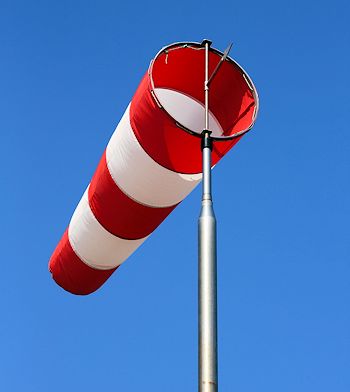Subscriber question:
"At my airport, we have two windsocks which seldom agree due to elevation differences, trees, etc. Which one should I trust?" - Brian W.
Wally:
 “The best indication of the wind that will affect your takeoff or landing is the windsock located near the runway.
“The best indication of the wind that will affect your takeoff or landing is the windsock located near the runway.
In the case you describe, the windsocks are giving conflicting information. Often this can be the result of local obstructions near one windsock. I have seen airports where a windsock was placed near a runway but almost up against a line of trees. When the wind was from certain directions, the trees either blocked the wind from the sock or caused it to be inaccurate due to the trees deflecting the wind. At this airport, there was also a windsock on top of a large hangar. That was the one that provided the prevailing winds at approximately 50 feet above the ground.
I have also seen situations where a windsock at one end of the airport was blowing in a certain direction and the windsock at the other was blowing in the opposite direction. This was a clear indication of windshear and in fact, a gust front from an approaching thunderstorm was passing over the airport. Anytime the winds are strong and gusty and appear to be coming from different directions at different spots on the airport, that is a sure sign of trouble and you should not attempt to operate there until the situation changes.
Sometimes on warm and sunny days, with the wind rather light and variable, you might see a windsock suddenly show a gusty wind that may last for only a minute or two. This is most likely the result of a thermal breaking free of the surface and as it rises cooler air flows in behind it. This situation usually only lasts for a short time but could create unexpected turbulence if you fly through the area. Usually delaying for just a minute or two will allow conditions to return to normal
As long as conflicting winds are light and variable and your takeoff or landing distance is not marginal, they should not cause you any serious problems. But, if your takeoff or landing is in any way marginal, you should not proceed unless you can confirm that you will be operating with a headwind. Even light tailwinds can cause a significant change in takeoff or landing performance and have been the cause of many accidents.”
Which of the following do you find most useful for gauging current wind conditions when landing?

